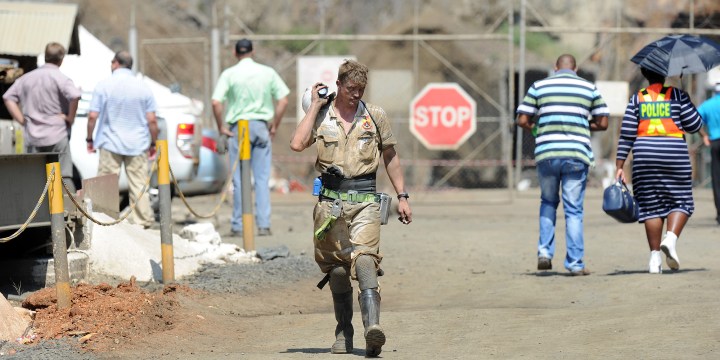MPUMALANGA MINING DISASTER
‘Mr X’s’ testimony at Lily Mine inquest paints chilling picture of illegal mining facilitated by employees

The findings from the Lily Mine inquest included first-hand accounts of the mine’s collapse in 2016 as well as extensive allegations of illegal mining, which was allegedly facilitated by mine employees.
In his testimony at the Lily Mine inquest, an anonymous witness, “Mr X”, told the court that gold buyers and mine employees provided illegal mine workers with drilling equipment and generators in exchange for payment in gold.
The court made a number of referrals to the National Prosecuting Authority (NPA) and ordered that Mr X’s identity be protected until the matter is finalised with the Director of Public Prosecutions. Mr X is a registered informant with the Hawks and Crime Intelligence and was also giving information to private security firm Fidelity.
The inquest proceedings dealt with the deaths of Solomon Nyirenda, Yvonne Mnisi and Pretty Nkambule. They died during the Lily Mine collapse on 5 February 2016 in Barberton, Mpumalanga. The inquest identifies illegal mining as one of the contributing causes.
The three mine employees were working in a container above ground that plunged into a sinkhole, trapping them underground. Rescue efforts continued for days, but proved futile. Seven years later, their bodies have still not been recovered.
A total of 33 witnesses testified during the inquest, which ran from November 2021 to February 2023, with Magistrate Annemarie van der Merwe handing down her findings on Thursday, 19 October.
The findings contained a number of concerning points, particularly in relation to the operation of illegal miners at the mine.
Read more in Daily Maverick: SAPS, DMRE and Lily Mine ‘all contributed to deaths’ in horror 2016 Mpumalanga collapse
Alleged corruption
Mr X told the court he had worked in the mining industry but became an illegal miner after losing his job. He was recruited as an informant in 2009 and was formally employed by Lily Mine at the time of the collapse. Van der Merwe said the “broad strokes” of his evidence were in line with other witnesses’ testimonies.
“The court finds the evidence of Mr X to be credible and reliable,” Van der Merwe said.
Mr X testified that Nyirenda, one of the three mine employees who died, had assisted the illegal miners by issuing them lamps and equipment used by mine employees who were on leave at the time. He allegedly charged up to R1,000 per person.
Former Lily Mine shift boss Jacobus Potas told the court that an investigation revealed that Nyirenda’s brother, the late Constable Eugene Nyirenda, was also involved in the illicit gold trade. The constable was killed at the Emasakeni tavern in Low’s Creek on 14 November 2009. Potas told the court the constable’s killing was allegedly related to the illegal gold trade.
Reliving the disaster
The evidence presented at the inquest paints a chilling picture of the Lily Mine accident. Recalling that fateful day was truck driver Aaron John Sithole, who arrived at the lamp room at 8am on Friday, 5 February 2016, to begin his shift.
He was the last of the operators to report for duty, the last to enter the mine that morning, and the last to view the lamp room in the container and the three deceased alive. He took his truck and followed his colleagues through the 2-Level portal into the mine’s belly after signing in on the underground register.
He turned on his headlights as he entered the portal for the long ride down the drive to 8-Level East and 12-Level West, where blasting was carried at 6.22am that day, and where the gold-bearing ore was ready to be loaded and trucked out of the mine for processing.
At that moment, according to Sithole, everything went dark, and the air became thick with choking dust. He stopped his truck because the blackness around him was impenetrable even with his headlights on.
Sithole got out of his truck and proceeded to the tail end of the vehicle to inspect. He noticed the soil receding behind the truck as he turned around, and he found himself on a precipice. He realised, through the swirls of dust, that an avalanche of sinking earth was carrying the lamp room and other surface structures into the mine’s depths.
Another witness, shop steward Cedrick Abednigo Magongo, who was sitting in his office on the day of the incident, testified that he was preparing for an upcoming hearing scheduled for later in the day. He had just returned from discussing it with Nyirenda in the lamp room, when a loud noise drew his attention.
When he approached the mine entrance, he noticed the lamp room, containers, generator and water tanks disappearing into the mine in a cloud of dust and smoke.
The inquest heard from David Michael Begg, a trained geologist and director of operations at the time of the incident, that the lamp room comprised two shipping containers that were welded together to form a double-capacity space.
Begg and mine overseer Philipus Johannes Storm testified that the containers created a stable, strong and secure structure, as long as they were on a level surface.
Both believed that during the collapse the containers broke apart in the middle where they were welded together and that they were subsequently squashed under the tons of collapsed rock and other material.
Cause of crown pillar collapse
The court received technical assistance from two assessors, mining engineer Henk Fourie and a rock mechanic Deon Louw, to understand the science of mining.
The crown pillar, located between the roof of levels three and four underground, collapsed and caved into the old underground workings. Explaining the cause of the collapse, Van der Merwe reiterated that only “potential hanging wall failure” and “blasting impact” could have contributed to the crown pillar collapsing in normal circumstances.
However, the court also found evidence that demonstrated that the natural rocks were strong and stable and that there was scaling at the crown pillar, but no other sign of impending wall failure.
The inquest findings revealed extensive illegal mining activities in Lily Mine, notably inside the crown pillar. The court determined that the probability of “stopes”, or dugout tunnels, being created inside the crown pillar, was compelling.
Van der Merwe stated in less technical terms: “The mining activities of the illegal miners inside the crown pillar had hollowed the crown pillar and weakened its structure. Because the weakened structure of the crown pillar was no longer able to withstand the forces the original solid structure was designed to withstand, the hollowed-out and weakened crown pillar structure caved into itself and gave way.
“On the evidence presented, the court therefore finds with the technical assistance of the assessors that illegal mining inside the crown pillar was the primary cause for the collapse of the crown pillar.”
The magistrate reiterated that it was necessary for the mining industry to take note of the Lily Mine disaster and the cause of the failure of the crown pillar.
Illegal mining
The evidence of Mr X shed light on how zama zamas had mined inside the crown pillar. His testimony was essentially that illegal mining at Lily Mine was out of hand before the disaster, with around 50 groups of between 10 to 20 each, operating at the mine at the time of the incident.
According to his testimony, the gold buyers provided the illegal miners with the necessary drill equipment and generators and the zama zamas would then pay for the equipment in gold.
“The legally employed mine workers would provide them food, mainly chicken, tinned food and bottled cold drinks in a bartering system where gold was received in exchange commodities.
“Entry into the underground work areas was either through paying bribes to the Fidelity security guards, who escorted them to the sites or by entering the mine dressed and equipped as legal mine workers,” the hearing heard from Mr X.
Mr X further disclosed that explosives were obtained with the help of legal mining workers or by breaking open explosive storage crates. Mr X testified that the zama zamas were interested in the crown pillar since it contained substantial quantities of visible gold. The court found that Mr X was aware of the location and purpose of the crown pillar.
“He not only indicated its location on the plans but also explained in detail how zamas gained access to it through the building of ‘scaffolding’ against the walls of the worked-out stopes on 3 Level.
“Mr X further explained how they tunnelled and mined horizontally into the crown pillar by following the ‘band of gold’. They drilled 35 to 40mm holes with drills, powered either through long extension cables plugged into the mine’s electricity supply or from generators,” the court found.
Van der Merwe also emphasised that Mr X had been in the crown pillar only once as the zamas had an arrangement that allowed everybody an opportunity to remove gold from the crown pillar.
“The day after the incident, Mr X spoke to an illegal miner who informed him that the zamas were blasting the crown pillar on the day of the incident,” the magistrate’s findings read.
Mr X’s handler at the time, Dirk Johannes van der Berg, a security specialist employed by the Fidelity Group, also confirmed Mr X’s evidence.
Van der Berg recruited Mr X, who had previously been arrested for illegal mining, as a registered informant in 2009 and deployed him from 2014 to 2016 to Lily Mine, because the explosives used in cash-in-transit bombings were allegedly coming from the mine.
Van der Berg said the illegal operations underground were intensive and the illegal miners were very well armed and sold the gold to organised crime structures.
Private security and findings
In order to deal with the continual threat of illicit mining and the challenges it provided, the Lily Mine hired private security. However, the court found this to be completely insufficient.
Furthermore, the court determined from the evidence that these security organisations functioned in a military-like manner in their efforts to limit the hazards involved with illicit mining.
“Mine houses cannot run their own private police forces or prosecution entities and must report illegal mining to the branches of the government which are responsible for law and order,” the court said.
The primary responsibility, Van der Merwe pointed out, for the protection of people and the combating of illegal activities lay with the state and, in particular, the SAPS, also mentioning the role of the Department of Mineral Resources and Energy (DMRE).
“It is clear from the evidence presented that the SAPS and the DMRE were at the time of the Lily Mine disaster, merely giving lip service to the issue of illegal mining and that they were not effectively addressing the issue.
Meanwhile, Cosatu in Mpumalanga has expressed shock at the inquest findings.
The trade union federation has called for a proper criminal investigation and urged the NPA as instructed by the court to prosecute those accountable.
The SAPS did not respond to the inquest finding’s criticisms of the police or the damning evidence related to the death of Constable Nyirenda. DM


















 Become an Insider
Become an Insider
Comments - Please login in order to comment.